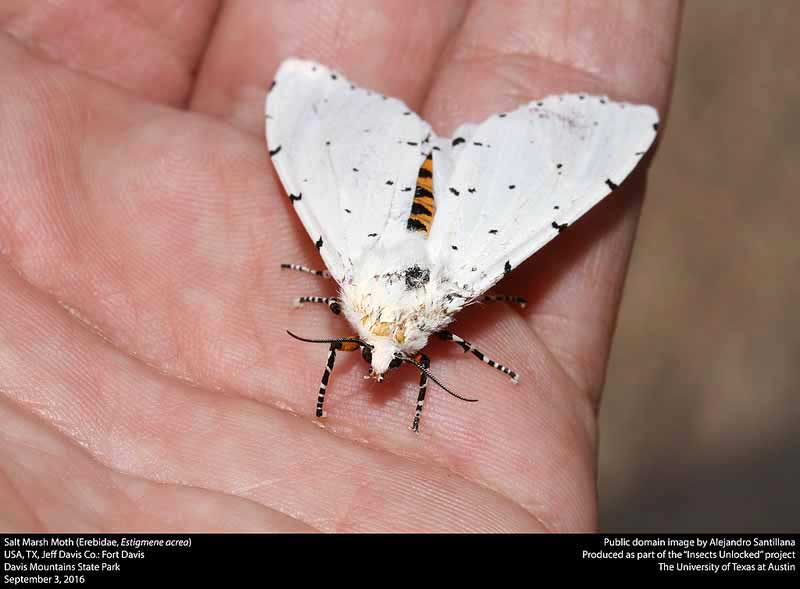
Superregnum: Eukaryota
Cladus: Unikonta
Cladus: Opisthokonta
Cladus: Holozoa
Regnum: Animalia
Subregnum: Eumetazoa
Cladus: Bilateria
Cladus: Nephrozoa
Cladus: Protostomia
Cladus: Ecdysozoa
Cladus: Panarthropoda
Phylum: Arthropoda
Subphylum: Hexapoda
Classis: Insecta
Cladus: Dicondylia
Subclassis: Pterygota
Cladus: Metapterygota
Infraclassis: Neoptera
Cladus: Eumetabola
Cladus: Endopterygota
Superordo: Panorpida
Cladus: Amphiesmenoptera
Ordo: Lepidoptera
Subordo: Glossata
Cladus: Coelolepida
Cladus: Myoglossata
Cladus: Neolepidoptera
Infraordo: Heteroneura
Cladus: Eulepidoptera
Cladus: Ditrysia
Cladus: Apoditrysia
Cladus: Obtectomera
Cladus: Macroheterocera
Superfamilia: Noctuoidea
Familia: Erebidae
Subfamilia: Arctiinae
Tribus: Arctiini
Subtribus: Spilosomina
Genus: Estigmene
Species: Estigmene acrea
Name
Estigmene acrea (Drury, 1773); Illust. nat. Hist. exot. Insects 2: index to vol. 1; 1770, ibidem 1: 7, pl. 3, fig. 2.
Type locality: “New York … Maryland and Virginia … Nouvelle York … Maryland & la Virginie”.
Synonyms
Phalaena Bombyx acrea Drury, 1773
acraea, missp.
Phalaena Bombyx caprotina Drury, 1773); Illust. nat. Hist. exot. Insects 2: index to vol. 1; 1770, ibidem 1: 7, pl. 3, fig. 3. Type locality: “New York … Maryland and Virginia … Nouvelle York … Maryland & la Virginie”.
acria (Fabricius, 1793), missp.
Arctia pseuderminea Harris, 1823; Rep. Ins. Inj. Veget.: 251
Leucarctia californica Packard, 1864; Proc. Ent. Soc. Phil. 3: 125. Type locality: “San Francisco, Cal.[ifornia]”
Spilosoma mexicana Walker, 1864; List Specimens lepid. Insects Colln. Br. Mus. 31: 291–292. Type locality: “Oajaca, Mexico”.
Leucarctia packardii Schaupp, 1882; Check-List Brooklyn Entom. Soc.: 8 .
Leucarctia rickseckeri Behr, 1893; Zoë 4: 247 .
Leucarctia acræa klagesii Ehrmann, 1894; Canad. Ent. 26 (10): 292–293. Type locality: “[no locality given] several specimens in various collections”.
echo Rothschild, 1910, part, the female
References
Drury, D., 1773: Illustrations of Natural History. Wherein are exhibited upwards of two hundred and twenty figures of exotic insects, according to their different genera; very few of which have hitherto been figured by any author, being engraved and coloured from nature, with the greatest accuracy, and under the author’s own inspection, on fifty copper-plates. With a particular description of each insect; interspersed with remarks and reflections on the nature and properties of many of them. London. – (1770) Vol. 1: i-xxvii, 1-130 p., 1-50 pl., Vol. 2: 92 p., 50 pl.
Ehrmann, G.A., 1894: A few remarkable variations in Lepidoptera. The Canadian Entomologist 26 (10): 292–293.
Packard, A.S., 1864: Synopsis of the Bombycidæ of the United States. Proceedings of the Entomological Society of Philadelphia 3: 97–130.
Rothschild, W., 1910: Catalogue of the Arctianae in the Tring museum, with notes and descriptions of new species. Novitates Zoologicae 17 (1): 1–85, (2): 113–188, pl. XI-XIV, 18: pl. III-VI, London and Aylesbury.
Walker, F., 1864 [1865]: List of the Specimens of Lepidopterous Insects in the Collection of the British Museum 31, suppl.: 321 p., Edward Newman: London.
Estigmene acrea, the salt marsh moth or acrea moth, is a moth in the family Erebidae. The species was first described by Dru Drury in 1773.[2] It is found in North America, the Democratic Republic of the Congo, Kenya, Colombia, Mexico.
Description
The head and thorax are white and the abdomen is yellow orange with a row of black spots. The forewing is white with a variable pattern of black spots, with some individuals lacking any spots. The hindwing is yellow orange in males and white in females. Both sexes have three or four black spots or blotches on the hindwings. The wingspan measures 4.5 to 6.8 centimetres (1+3⁄4 to 2+11⁄16 in).[3]
Flight
This moth is generally seen from May to August,[3] but it is seen all year in southern Florida and southern Texas.[4]
Life cycle
The yellowish eggs are laid in clusters on the host plant leaves. The larva, known as the salt marsh caterpillar, which grows to about 5 cm (2 in) in length, is highly variable in color, ranging from pale yellow to rusty orange brown to dark brownish black. It is hairy, with numerous soft setae, growing in tufts (several tufts on each segment), with a few individual hairs that are longer toward the end of the body. The thoracic and abdominal segments have a few rows of orange or black warts, and it has one tiny white dot per segment, on both sides of its body. It pupates in a cocoon, made in part from its own hair, usually by wrapping itself in a leaf or other debris.[4] While inside the cocoon, it remains a larva through the winter, pupates in spring, and emerges as an adult in late spring. In the southern parts of its range it may have several generations per year.
Host plants
Host plants used by the caterpillar include dandelions, cabbage, cotton, walnuts, apple, tobacco, pea, potato, clovers, and maize.[3][4]
The moth does not seem to be affected by any type of pyrrolizidine alkaloid present in many plant families, including the borage, legume, dogbane, and orchid families, and the tribes Senecioneae and Eupatorieae of the aster family. It is sensitive to alkaloids due to its pyrrolizidine alkaloid-specific taste receptors. It can detoxify them and even convert them into sex pheromones.[5]
Subspecies
Estigmene acrea acrea
Estigmene acrea arizonensis Rothschild, 1910 (Arizona)
Estigmene acrea mexicana (Walker, [1865}) (Mexico)
Estigmene acrea columbiana Rothschild, 1910 (Colombia)
References
"Catalogue of the Exhibit of Economic Entomology at the Louisiana Purchase Exposition, St. Louis, Mo., 1904". Some Miscellaneous Results of the Work of the Division of Entomology. United States Bureau of Entomology (47): 45. 1904.
"Saltmarsh caterpillar". Entomological Society of America. Retrieved July 9, 2018.
Covell, C. V. (2005). Moths of Eastern North America. Virginia Museum of Natural History, Martinsville, VA. ISBN 1-884549-21-7
Wagner, D. L. (2005). Caterpillars of Eastern North America. Princeton University Press, Princeton, NJ. ISBN 0-691-12144-3
Hartmann, T., et al. (2005). "Specific recognition, detoxification and metabolism of pyrrolizidine alkaloids by the polyphagous arctiid Estigmene acrea". Insect Biochemistry and Molecular Biolog
Retrieved from "http://en.wikipedia.org/"
All text is available under the terms of the GNU Free Documentation License


